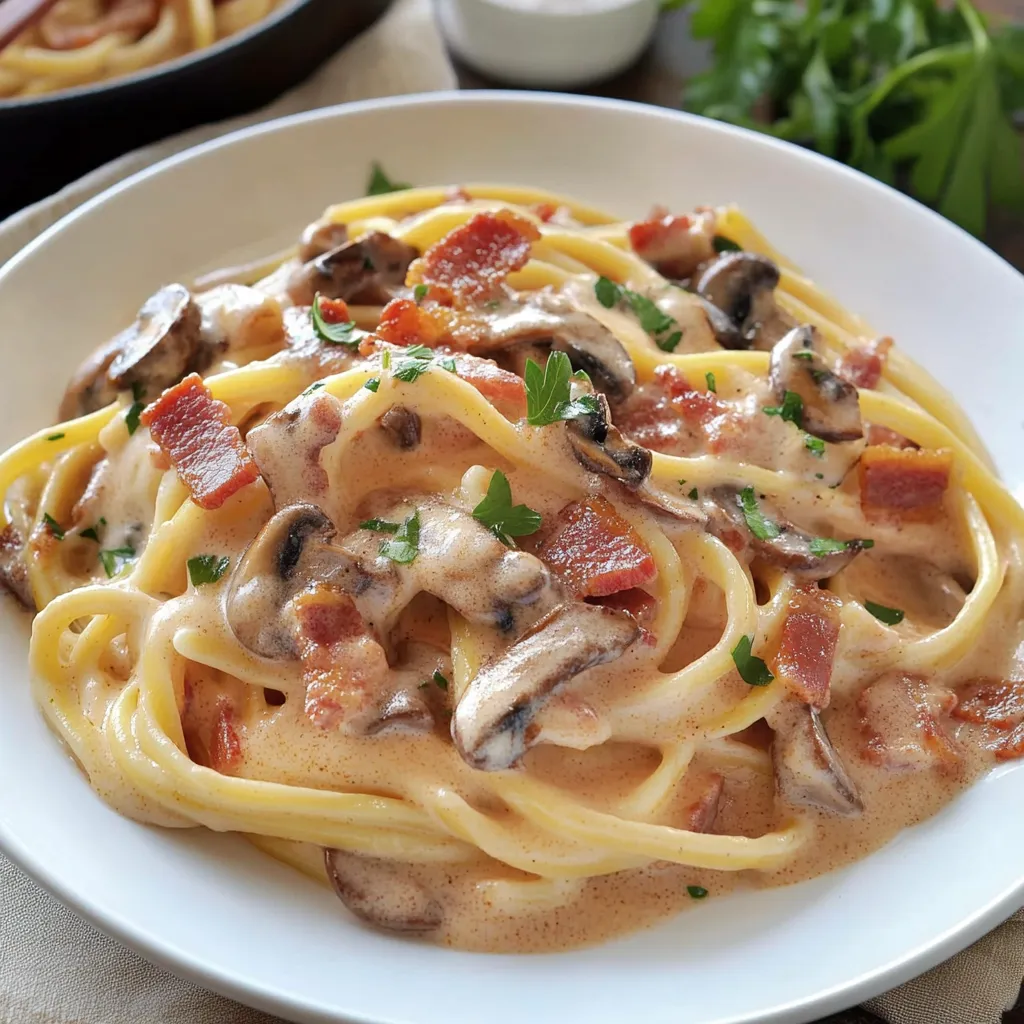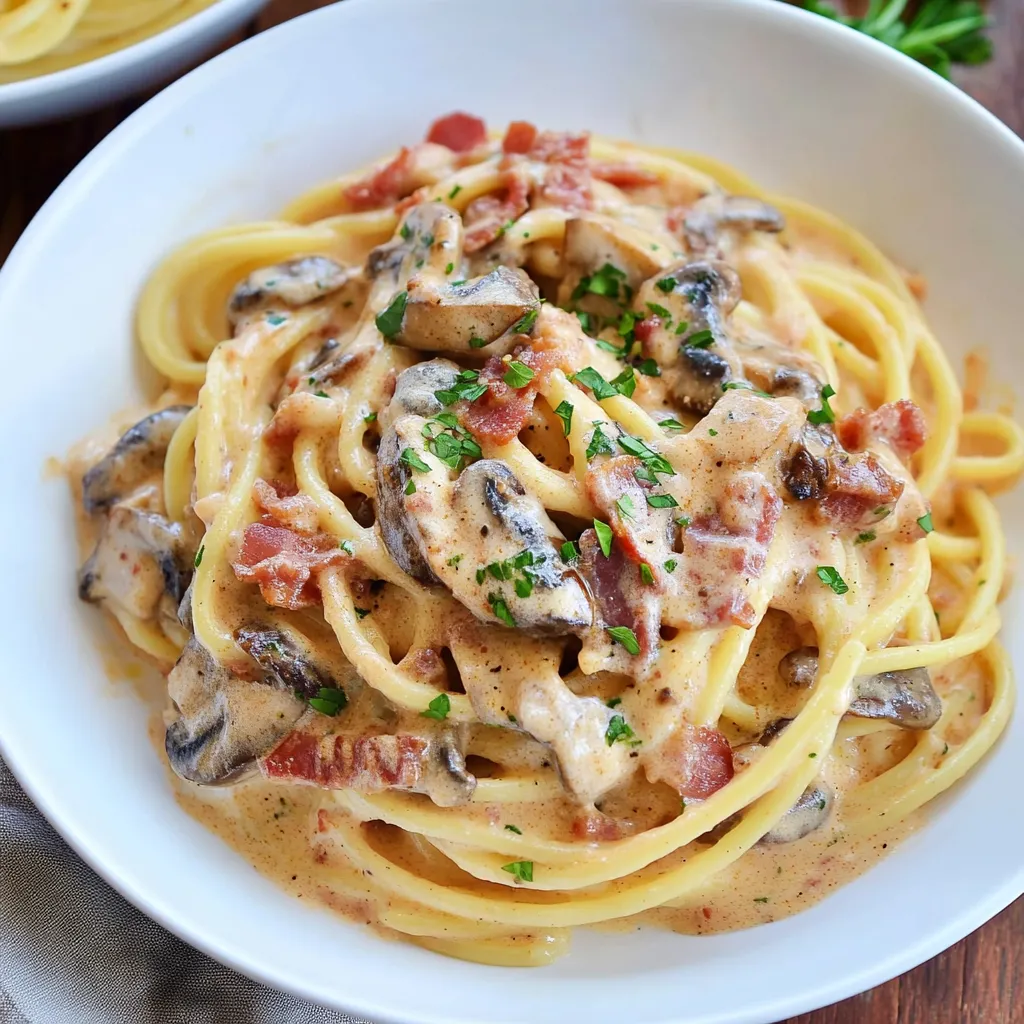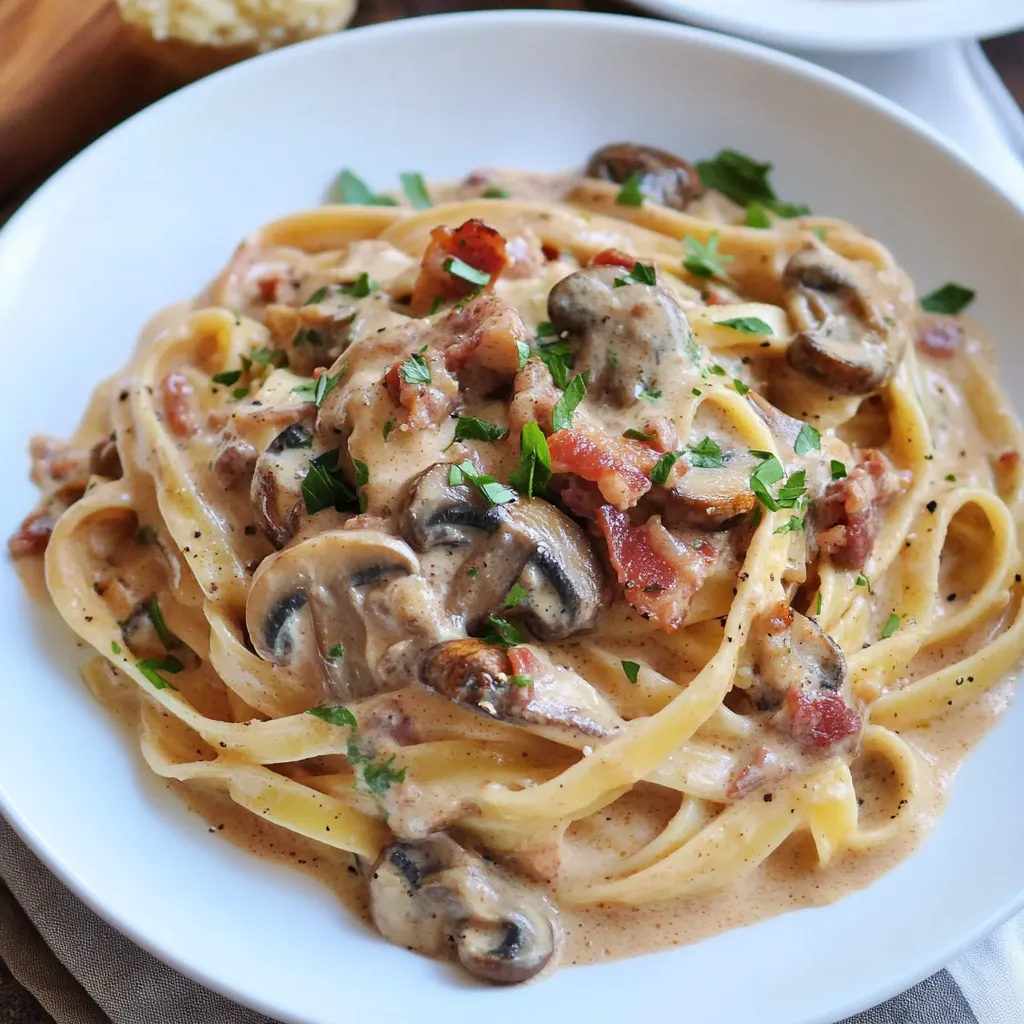 Pin it
Pin it
This rustic pasta Boscaiola celebrates the earthy flavors of the Italian countryside with a creamy tomato sauce studded with mushrooms and bacon. The dish originated with Italian woodcutters (boscaioli) who would gather mushrooms from the forest to create this hearty meal after a long day's work.
I first made this pasta Boscaiola during a cold winter evening when I was craving something comforting but didn't want to leave the house. The combination of smoky bacon and woodland mushrooms has made it a regular in our dinner rotation ever since.
Ingredients
- Thick cut bacon: Adds a smoky depth and richness that defines the sauce
- Fresh mushrooms: Provide earthy flavor and meaty texture. Use cremini or a mix of wild varieties for best results
- Onion and garlic: Create the aromatic base essential for building layers of flavor
- Fresh thyme: Complements the earthiness of mushrooms with its subtle woodsy notes
- Whole canned tomatoes: Offer better texture and flavor than pre-diced varieties. San Marzano are ideal if available
- Dry white wine: Adds acidity and complexity. Choose something you would drink like Pinot Grigio or Sauvignon Blanc
- Pasta: Choose long ribbon pastas like pappardelle or fettuccine to hold the chunky sauce
- Heavy cream: Creates silky richness without overwhelming the other flavors
- Peas: Add a pop of sweetness and bright color
- Fresh parsley: Brightens the finished dish with herbaceous notes
Step-by-Step Instructions
- Cook the bacon:
- Place chopped bacon in a Dutch oven or large sauté pan over medium-high heat. Cook for 5-7 minutes, stirring frequently to ensure even browning. The fat should render completely and the bacon should become crispy. Transfer to a paper towel-lined plate using a slotted spoon, leaving the flavorful fat in the pan.
- Brown the mushrooms:
- Add sliced mushrooms to the bacon fat and cook over medium-high heat for about 8 minutes, stirring occasionally. Allow them to sit undisturbed for parts of the cooking time to develop a deep brown caramelization. This step is crucial for developing the mushrooms' complex flavor.
- Sauté aromatics:
- Add the sliced onion, minced garlic, and thyme to the mushrooms. Cook for 5-6 minutes until the onions become translucent and slightly golden. The garlic should be fragrant but not browned, which would create bitterness.
- Create the sauce base:
- Pour in the puréed tomatoes and white wine, scraping the bottom of the pan to release any browned bits. Season with salt and pepper. Bring to a simmer, then reduce heat to maintain a gentle bubble. Allow to simmer for 10-15 minutes, during which the alcohol will cook off and the flavors will concentrate.
- Cook the pasta:
- While the sauce simmers, bring a large pot of water to a rolling boil. Add 1-2 tablespoons of salt; the water should taste like the sea. Add pasta and cook until al dente, typically 1-2 minutes less than package directions. Before draining, reserve about a cup of the starchy pasta water.
- Finish the sauce:
- Add the heavy cream, peas, drained pasta, and reserved bacon to the sauce. Bring to a gentle simmer, adding small amounts of the reserved pasta water as needed to reach your desired consistency. The starchy water helps the sauce cling to the pasta. Cook for 1-2 minutes until the peas are bright green and just warmed through.
 Pin it
Pin it
My absolute favorite element of this dish is the way the mushrooms absorb the bacon flavor while developing their own caramelized richness. My Italian grandmother always said the secret to a good Boscaiola is patience with the mushrooms – never crowd the pan and give them time to brown properly.
Wine Pairing Suggestions
This robust pasta dish pairs beautifully with medium-bodied red wines. A Sangiovese-based wine like Chianti Classico complements the tomato acidity while standing up to the richness of the bacon and cream. For white wine lovers, a full-bodied Chardonnay with subtle oak influence provides enough structure to match the dish's heartiness.
Customization Options
Vegetarian version: Replace bacon with 2 tablespoons olive oil and add 1 teaspoon smoked paprika for depth. Use a variety of mushrooms like shiitake, oyster, and porcini for complex flavors.
Make-Ahead Tips
The sauce (without cream and peas) can be prepared up to 3 days ahead and refrigerated in an airtight container. When ready to serve, reheat gently on the stovetop, add the cream and peas, then toss with freshly cooked pasta.
 Pin it
Pin it
This dish is a warm embrace of Italian tradition that you'll love serving for any occasion.
Frequently Asked Questions
- → What type of pasta works best for Boscaiola sauce?
Wide, flat pasta varieties like pappardelle, fettuccine, or tagliatelle work best as they provide more surface area to hold the hearty, creamy sauce. These pasta shapes stand up well to the substantial ingredients like bacon and mushrooms.
- → Can I make Pasta Boscaiola ahead of time?
You can prepare the sauce a day ahead and refrigerate it. When ready to serve, gently reheat the sauce, cook fresh pasta, and combine. Add a splash of pasta water if the sauce needs thinning. For best results, add the cream only during reheating to prevent it from breaking.
- → What can I substitute for wine in Pasta Boscaiola?
If you prefer not to use wine, substitute with chicken or vegetable broth plus 1 tablespoon of lemon juice or white wine vinegar to add acidity. This maintains the depth of flavor without using alcohol.
- → How can I make this dish vegetarian?
For a vegetarian version, omit the bacon and sauté the mushrooms in olive oil or butter instead. Add a teaspoon of smoked paprika and a tablespoon of soy sauce to introduce umami flavors that would otherwise come from the bacon.
- → What mushrooms work best in Pasta Boscaiola?
Classic cremini or button mushrooms work well, but for more complex flavor, try a mix of wild mushrooms like shiitake, oyster, or porcini. Dried porcini mushrooms rehydrated in hot water add incredible depth—just add their strained soaking liquid to the sauce.
- → Can I freeze leftover Pasta Boscaiola?
Cream-based sauces typically don't freeze well as they can separate when thawed. It's best to enjoy this dish fresh or refrigerate leftovers for up to 3 days. If you want to freeze portions, consider freezing just the sauce without cream, then add fresh cream when reheating.
